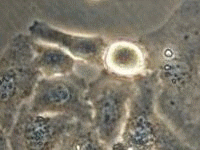BRAIN CANCER STOPPED BY SCORPION VENOM
Cutting the Spread of Tumors
Scientists have been looking at chlorotoxin, a peptide in
scorpion venom, for the past decade as a way to target
cancer cells. And the big payday has arrived. By combining nanoparticles with a scorpion venom mix already being investigated for treating
brain cancer,
University of Washington researchers found they could cut the spread of cancerous cells by 98 percent, compared to 45 percent for the scorpion venom alone (
www.uwnews.org).
This is the first time that nanoparticles, which are
ultrafine particles, have been combined with a treatment that physically stops cancer’s spread. “People talk about the treatment being more effective with nanoparticles but they don’t know how much, maybe 5 percent or 10 percent,” said Miqin Zhang, professor of
materials science and engineering. “This was quite a surprise to us.” She is lead author of the study.
Chlorotoxin binds to a surface protein on many types of
tumors, including brain cancer. Chlorotoxin also disrupts the spread of tumors.
The Whole is Greater than the Parts
The researchers investigated chlorotoxin when it is attached to nanoparticles and found that the treatment’s effect doubles compared to chlorotoxin alone. Adding nanoparticles often improves a therapy, partly because the combination lasts longer in the body and so has a better chance of reaching the tumor. Combining also boosts the effect because therapeutic
molecules clump around each nanoparticle.
Slowing the spread of cancer would be especially useful for treating highly invasive tumors, such as brain cancer. The technique could hypothetically also slow the spread of other tumors with the same kind of activity, such as breast, colon, skin, lung, prostate, and
ovarian cancers.




